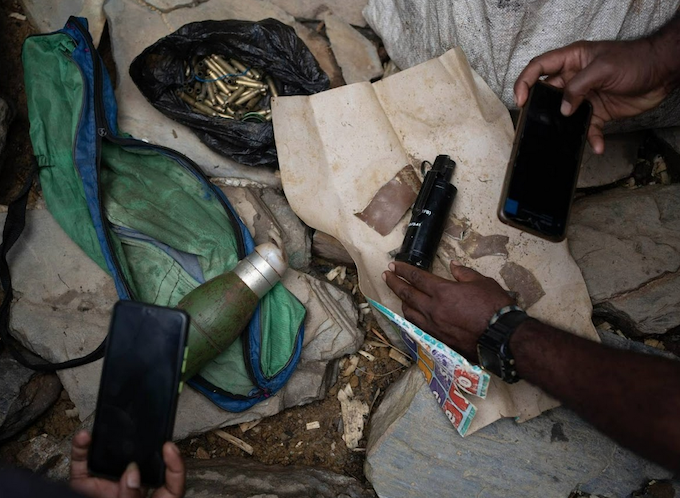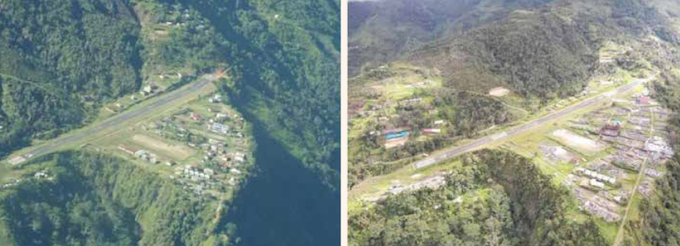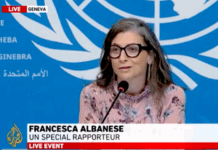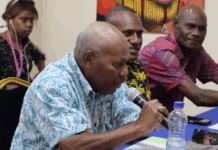
A chilling new report by a German-based human rights watchdog has exposed indiscriminate attacks by Indonesian security forces on indigenous West Papuan villages, highlighting an urgent need for international action.
The 49-page report, “Destroy Them First . . . Discuss Human Rights Later”, is an investigation of the Indonesian forces in the remote Kiwirok area in Pegungan Bintang Regency in the Papuan highlands.
Satellite imagery and on the ground analysis by researchers shows the destruction of eight villages in 2021 and 2022 — Mangoldogi, Pelebib, Kiwi, Oknanggul, Delmatahu, Spamikma, Delpem and Lolim.
- READ MORE: New documentary, human rights report allege Indonesian atrocities in West Papua
- Other West Papua reports

A total of 206 buildings, including residential homes, churches and public building buildings have been destroyed in the raids, forcing more than 2000 Ngalum villagers to seek refuge as internally displaced people (IDPs) in the surrounding forest in destitute circumstances.
In a statement, the Human Rights Monitor said the report — released today — provided a “meticulous and scientific analysis” of the Indonesian forces’ attacks on the villages.
“This report sheds light on the gravity and extent of violations in the Kiwirok region and measures them against international law,” the statement added.
Eliot Higgins, director at Bellingcat, a Netherlands-based investigative journalism group specialising in fact-checking and open-source intelligence, said: “This in-depth report provides evidence of security force raids carried out in the Kiwirok District, impacting on both indigenous villages and public properties.
‘Harrowing picture’
“It paints a harrowing picture of more than 2000 villagers displaced and forced to live in subhuman conditions, without access to food, healthcare services, or education.
“The main findings of this report include instances of violence deliberately perpetrated
against indigenous Papuan civilians by security forces, leading to loss of life and forced
displacement which meet the Rome Statute definition of crimes against humanity.”

The report says that the armed conflict in West Papua has become “significantly aggravated since December 2018, as TPNPB [West Papua National Liberation Army] members killed at least 19 road workers in the Nduga Regency.
“That incident marks the re-escalation of the armed conflict in West Papua. The conflict statistics show a continuous increase in violence over the past three years, reaching a new peak in 2022. The number of civilian fatalities related to the conflict rose from 28 in 2021 to 43 in 2022,” added the report.
Usman Hamid, Amnesty International’s Indonesia director said: “Impunity for violence by the security forces is a major concern from both a human rights and a conflict perspective.
“This report provides the necessary information for the National Human Rights Commission, Komnas HAM, to take up the case.
“Without accountability for the perpetrators, the chances of a lasting solution to the conflict in Papua are slim,” he added.

‘Hidden crisis’
Peter Prove, director for international affairs at the World Council of Churches, said:
“The World Council of Churches has been monitoring the conflict in West Papua — and its
humanitarian, human rights and environmental impacts — for many years.
“But it remains a hidden crisis, largely forgotten by the international community — a situation that suits the Indonesian government very well. This report helps shine a small but telling beam of light on one specific part of the conflict, but from which a larger picture can be extrapolated.
“Indonesia — which is currently campaigning for election to the UN Human Rights Council — must provide more access and transparency on the situation in the region, and the
international community must respond appropriately to the increasing gravity of the crisis.”
Disturbing revelations in this new Human Rights Monitor report on the bombing of indigenous villages in Kiwirok, West Papua. The world must stand united against such atrocities. Read the full report here: https://t.co/5ySOZt7T2R🕊️ #HumanRights #CrimesAgainstHumanity pic.twitter.com/QxIWmPK4C8
— Human Rights Monitor (@hurimonitor) August 16, 2023
In light of the findings, Human Rights Monitor has called on the international community,
governments, and relevant stakeholders to:
- Immediately ensure humanitarian access for national and international humanitarian
organisations and government agencies to the Kiwirok District. Humanitarian aid
should be provided without involving security force members to ensure that IDPs can
access aid without fearing reprisals; - Instruct the National Human Rights Commission (Komnas Ham) to investigate
allegations of serious human rights violations in the Kiwirok District between 13
September and late October 2021; - Immediately withdraw non-organic security force members from the Kiwirok District,
allowing the IDPs to return and re-build their villages without having to fear reprisals
and further raids; - Ratify the Rome Statute;
- Be open to a meaningful engagement in a constructive peace dialogue with the
United Liberation Movement for West Papua (ULMWP); and - Allow international observers and foreign journalists to access and work in West
Papua
Human Rights Monitor is an independent, international non-profit project promoting
human rights through documentation and advocacy. HRM is based in the European Union
and active since 2022.
Focused on West Papua, HRM states: “We document violations; research institutional, social and political contexts that affect rights protection and peace; and share the conclusions of evidence-based monitoring work.”












































